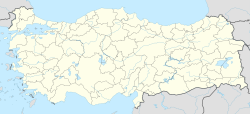Top Qs
Timeline
Chat
Perspective
Birgi
Neighbourhood in Ödemiş, İzmir, Turkey From Wikipedia, the free encyclopedia
Remove ads
Birgi is a neighbourhood in the municipality and district of Ödemiş, İzmir Province, Turkey.[1] Its population is 1,832 (2022).[2] Before the 2013 reorganisation, it was a town (belde).[3][4] Its current name is a turkified version of its medieval Greek name, Pyrgion (Greek: Πυργίον, meaning "Little Tower").
Remove ads
History
In antiquity, the town was known as Dios Hieron (Greek: Διός Ἱερόν, 'Sanctuary of Zeus'),[5] one of two cities thus named.[6] The city became part of the Roman Republic and the Roman province of Asia with the annexation of the Kingdom of Pergamon.
It was renamed to Christoupolis (Greek: Χριστούπολις) in the 7th century and was known as Pyrgion (Greek: Πυργίον) from the 12th century on.[5] Pyrgion fell to the Turks in 1307, and became the capital of the beylik of Aydin.[5]
Ibn Battuta visited the city and attended a lecture by the eminent professor Muhyi al-Din.[7]
It was subsequently incorporated into the Ottoman Empire in 1390.[8] Birgi is well known for its classic Seljuk and Ottoman architecture and has been listed as a World Cultural Heritage by ÇEKÜL(Protection and Promotion of the Environment and Cultural Heritage) since 1994.
In 2021, archaeologists unearthed a Byzantine fort.[9]
Remove ads
Bishopric
The Roman Era city had an ancient Christian Bishopric attested as an episcopal see from at least 451, It was a suffragan of Ephesus, which it remained under until the late 12th century when it became a separate metropolis.[5]
There are four known bishops of this diocese from antiquity.
- Stephen took part in the Council of Ephesus of 431
- Eustorgios was not present at the Council of Chalcedon (451) and his metropolitan, Stephen of Ephesus, signed on his behalf
- Zoetus was among the fathers of the Council of Constantinople of 680 and the Council in Trullo of 692
- Stephen of Pyrgion participated at the two Councils of Constantinople in 869–870 and 879–880 who dealt with the issue of Patriarch Photios I of Constantinople
Today Dioshieron survives as titular bishopric in the Roman Catholic Church,[10] so far the see has never been assigned.[11][12]
Remove ads
Notable historic structures
- Çakırağa Mansion — built in 18th-century Ottoman style by the wealthy Çakırağa family.
- Aydınoğlu Mehmet Bey Mosque — commissioned in 1313 by Mehmet Bey, the founder of the Aydinids.
- Aydınoğlu Baths (14th century)
- Tomb of Birgivi Mehmet Efendi (16th century)
- Birgivi Mehmet Efendi Madrasa (16th century)
- Sultanşah Mausoleum
- Fortress Madrasa, where Sultan Mehmed II the Conqueror (March 30, 1432 – May 3, 1481) was educated.
- Sandıkoğlu Mansion (19th century)
- Karaoğlu Mosque (18th century)
- Birgi city walls
- Iron Magazine (16th century)
References
Wikiwand - on
Seamless Wikipedia browsing. On steroids.
Remove ads



